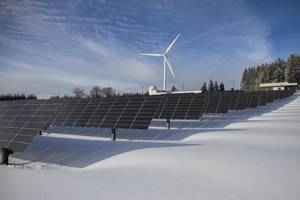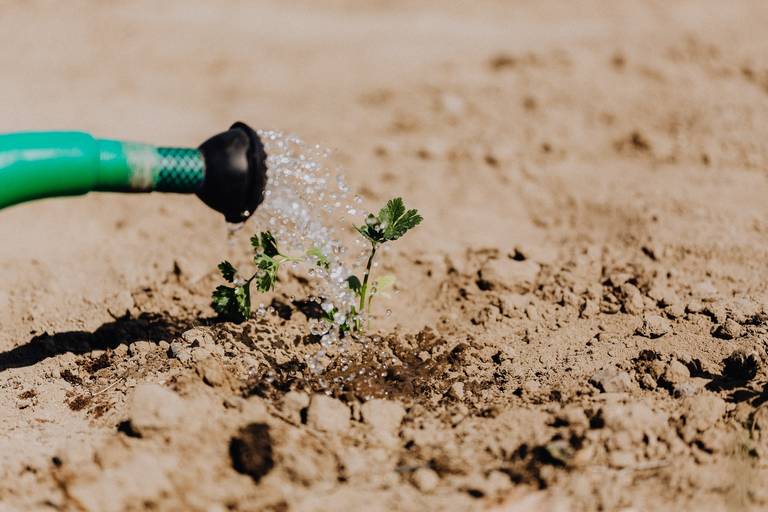Encouraging Wildlife in Garden: Build Your Own Wildlife Pond
On my journey to Jersey City the other day, I looked down upon garden after garden but only saw one pond in the whole 40-minute journey.
It made me realize just how far some poor creatures have to travel to get to a decent amount of accessible water that they can drink, bathe in, play in, and for some live in and reproduce in.
Water is the most important thing to any living creature. All it takes is a friendly gardener to spend a weekend digging a sympathetically shaped hole in their garden and filling it with water.
Wildlife needs us to create more ponds, so where better than in your own garden where you will have a ring-side seat to observe all the goings-on, writes Helen Taylor.
Frogs will quickly make use of your wildlife pond.
A wildlife pond is good for us humans too. Unfortunately, all gardeners seem to be at war with the dreaded slug. Still, many do not realize that lurking in their neighborhood are hundreds of slug-gobbling amphibians just waiting for a suitable pond to set up home in and a garden full of their favorite sluggy suppers.
Also, what better way to unwind after a hard day at work or to escape the nagging wife/husband/kids than by killing time watching incredible creatures such as iridescent damsels and dragonflies, basking frogs, newts, bathing birds, thirsty mammals? And if you're lucky, at dusk, even bats swooping down to grab a mosquito supper.
So hopefully, you've been persuaded to give up a bit of time, energy, and space in your garden to build your own wildlife pond. Here's how:
Table of Contents
Your first consideration is where to put your pond.
- Choose a part of the garden that is quiet and undisturbed so that the wildlife feel safe.
- Avoid putting it under deciduous trees and bushes as you will fight a constant battle with leaves blowing into it, polluting the water.
- Avoid placing it in the sunniest spot in the garden as the sunlight promotes the growth of algae. Too many algae can kill the natural ecology of the pond.
- Avoid constant shade as the pond will be cold, and plants and pond animals will not thrive.
- If you have young children, make sure it is in an area that can easily be fenced off.
- If you plan to have a moving water feature (bear in mind frogs don't particularly like moving water), you will need electricity.
- Be sure about your chosen site before you start digging. Please don't do as I did; get your kid to dig a big hole, then change your mind and make him fill it in and dig another big hole somewhere else!
Beauties and beasts alike will flock to your wildlife pond.
Size and Shape
- Your pond must have gradual shallow sloping sides so that pond dwellers can get in and out easily, birds can bathe and any non-swimming animal can escape if it falls in.
- It must have a deep area where hibernating creatures can sleep. The minimum depth required is 18", but the deeper, the better. I wouldn't go less than 24". If your neighbor has a deeper pond than yours, you will find that your slug gobblers will probably favor his pond because the deeper pond will have better water quality and be warmer in winter and cooler in summer.
- But before you decide to convert half your garden into a lake, consider that the larger you make your pond, the more pond liner will be required and consequently more money needed to pay for it.
Wildlife Pond Construction
What you will need:
- A pond liner of appropriate size. It is crucial to get this right, and the easiest is to find an online calculator. Don't forget to include the gently sloping edges in your measurements. Liners come in different quality and price. Some stockists, including Argos, do starter packs. Another popular company that offers pond kits is amazon.
- Some old carpet or sand to put between the ground and liner to protect it from stones
- Someone able and willing with spade and fork and a happy disposition to dig a big hole.
- A few big stones /logs to hold the line in place.
- A long plank of straight wood and a spirit level.
- A spade and fork.
At last time for action:
- Mark out your pond with a rope or hose-pipe
- Remove the turf and start digging the sloping sides. Incorporate some shelves about 12" down, making them about 12" wide (this is where you will put your baskets of marginals.
- Gradually dig down to your deepest area.
- Remove anything sharp that could damage the liner.
- Make sure that all the edges are level by putting your plank of wood from one side of the pond to the other and checking it with the spirit level. Do this in several places.
- Line the hole with a 1" layer of sand or some old carpet or both if you live in a stony area.
- Carefully lay out the liner and put stones around the edge to hold it in place.
- Start slowly filling it up with water, moving the stones as necessary to allow the liner to stretch into place.
- Now leave overnight or longer to let everything settle. Then check that the edges are level again.
Completing the Edges
- Small flat stones or round pebbles are best for the beached area with grass or plants at the water's edge. This gives animals some cover and makes them feel safer.
- Put a few loosely piled logs nearby for amphibians to hide there.
Now leave it for about a week to allow the chlorine in the water to disperse.
Planting for the pond
Always remember only to use aquatic soil when planting in your pond.
See also: Understanding different types of soil
Pond plants are a very important part of getting the ecosystem right and can make the difference between crystal clear water or algae choked pond, wildlife, or a mosquito crèche.
It would be best if you used native plants to attract wildlife.
- Only ever use aquatic soil.
- Before planning what plants you would like to use, see what is available from your local stockist as it is very frustrating if you decide on a particular plant and then find that nowhere local sells it.
- Plant in the growing season, late spring onwards.
You will need:
Oxygenating plants: These quick-growing, mostly submerged plants use up waste nutrients, thus depriving algae and keeping the pond clean. They also provide cover for all the pond residents and a place for amphibians to lay their eggs. Either plant in aquatic baskets or tie clumps to stones and sink them to the bottom.
Shade-giving plants: These plants reduce the amount of sunlight reaching the water, drastically reducing algae's ability to reproduce. The most effective shade givers are water lilies.
Marginals: These are the plants that grow at the edge of ponds on the shelves you made. There is a tremendous variety to suit all situations. Try to include different shapes and heights; frogs will hide amongst the lower growing foliage, and dragonfly larvae will migrate up the storks of tall plants like rushes and irises when they are ready to pupate. Nothing is so wonderful than catching the moment when the beautiful dragonfly struggles out of its ugly beetle-like larvae shell and flies away to a new life.
How to get your wildlife visitors
Your wildlife pond will become an important breeding ground in spring
Make the area around the pond hospitable to all sorts of wildlife with lots of grass and low shrubs corridors through which they can travel without feeling exposed.
Avoid gravel as small animals do not like it.
Take a bucketful of water from an already established pond as this will have lots of the minute organisms in it that will start the food chain.
Create habitats, e.g., log piles nearby. Do not use slug pellets.
Some Important Points:
- Young children and water do not mix. Never take chances and leave a child unattended in your garden if you have a pond.
- Plan your pond well before starting to dig. Get as much information as possible from the internet, books, and aquatic stores to know exactly what you want as it is complicated to change things once you have started.
- Do not put fish in your wildlife pond because they will eat the wildlife.
- Take time to understand and maintain the ecosystem of your pond otherwise, it will just become smelly and stagnant.
- Take time to just sit and enjoy it.
Outdoor Water Features: What's Right For You?
How you use outdoor water features in your garden can be as varied as a birdbath or a large reflecting pool.
Bird Bath
I expect you'll find birds there enjoying a splash.
Garden Pools
Garden pools (without plants or fish) still have a lot of options. However, reflecting pools is a calm respite at the end of the day.
Fountains
Many homes cover up the unwanted noise from nearby streets or highways with the sound of water.
Waterfalls
Waterfalls always draw the eye. The sounds of water splashing over rocks is soothing, and watching a waterfall can be as mesmerizing.
Pond Tips
Want to add that extra something special? -- consider the five senses:
- sight (color, shape, and texture)
- sound (water or chimes)
- touch (texture)
- taste (an herbal garden?)
- and smell (the scent can be a powerful thing in your garden).
Pond Maintenance
Outdoor water features have a wide variety of costs - both in initial costs and time maintaining it. Understanding your needs can help you to find the perfect way to introduce water into your landscape.
Sprinklers can be a fun addition to any landscape. Virtually carefree, many styles are emerging for today's homeowners.
Birdbaths have no moving parts and can be as simple as an artistic bowl on a pedestal. As a result, there is virtually no maintenance needed except cleaning it a few times a year.
Fountains are also a lower maintenance option. Keeping an eye out to make sure the pump is still functioning and full of water is all you need to be concerned about.
Garden pools without plumbing or living creatures will be a lower maintenance item. In addition, the correct installation of a pond liner will minimize puncture holes upon installation.
Because you're taking care of living creatures, garden ponds are probably the most maintenance. Careful balancing of the ecosystem can reduce time spent, so it's all the better for you if you're well-informed. This means careful planning at the beginning.
Now that we've covered maintenance, you might have a better idea of what type of outdoor water feature you'd like to see in your garden. Make sure you look into the details of maintenance so that you're prepared for the upkeep.
Be prepared - your family will be drawn to it just as you are. This is one item that has universal appeal!


